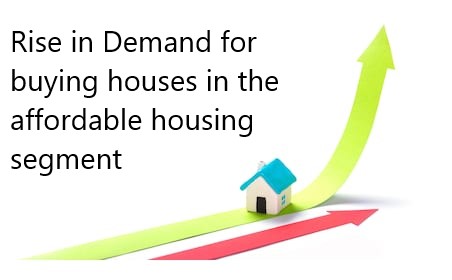Rise in Demand for buying houses in the affordable housing segment
Read latest blogs and articles from Housystan

The Information mentioned here was last updated on:
4/1/2026Understanding the Rise in Demand for Affordable Housing
In recent years, there has been a significant surge in the demand for affordable housing. With property prices soaring and cost of living on the rise, many individuals and families are seeking out options that won't break the bank. This trend is reshaping the real estate landscape, as both buyers and developers turn their focus towards this burgeoning market segment. But what is driving this demand, and how is it impacting the housing market?
Why Is Affordable Housing in High Demand?
- Verified Tenants/Buyers
- Unlimited Property Listing
- Zero subscription/charges fee
Several factors are contributing to the heightened interest in affordable housing:
- Economic Factors: Economic instability and stagnant wages have left many people unable to cope with high mortgage rates. Affordable housing provides a viable alternative for those struggling financially.
- Urbanization: As more people move to urban areas in search of better job opportunities, the demand for affordable housing in these regions has increased. This migration places additional pressure on urban real estate markets.
- Scarcity of Supply: There is often a limited supply of affordable homes, which can heighten demand when they do become available.
- First-Time Buyers: Many first-time buyers find it challenging to enter the housing market due to high prices. Affordable homes serve as an entry point into homeownership.
Key Characteristics of Affordable Housing
Affordable housing typically has a few specific characteristics:
1. Cost-Effective Construction: Builders use cost-effective construction methods and materials to keep prices down.
2. Smaller Spaces: These homes often feature smaller floor plans, which reduces the overall cost.
3. Location: They may be located in less expensive areas or in developing neighborhoods.
Impacts on the Real Estate Market
The shift towards affordable housing affects various aspects of the real estate market:
- Increased Competition: More buyers are competing for limited affordable homes, driving up demand and sometimes prices.
- Developer Interest: Builders are increasingly interested in the affordable housing market, leading to more developments that cater to this demand.
- Financing Options: Financial institutions are offering more tailored mortgage products to assist buyers in the affordable segment.
Challenges in Affordable Housing
While the demand for affordable housing is on the rise, several challenges persist:
- Zoning Regulations: Strict zoning laws can limit the areas where affordable housing can be developed, slowing down supply.
- Funding and Support: There is often inadequate funding for affordable housing initiatives, making it harder for developers to deliver projects at a low cost.
- Community Resistance: Some communities resist affordable housing projects due to misconceptions about their impact on property values.
The Role of Government and Policy
Government policy plays a critical role in facilitating affordable housing. Here's how it can drive change:
- Subsidies and Incentives: Governments can offer incentives to developers to build affordable housing, such as tax breaks or subsidies.
- Regulatory Reforms: Streamlining zoning laws and reducing bureaucracy can help increase the supply of affordable homes.
- Public-Private Partnerships: Collaborations between the public sector and private developers can accelerate affordable housing projects.
The Future Outlook
The future of affordable housing looks promising as demand is expected to grow. Here are some trends to watch:
1. Sustainable Development: There is an increasing focus on building environmentally sustainable affordable homes, which can reduce costs and attract eco-conscious buyers.
2. Innovative Housing Solutions: Creative solutions such as tiny homes and cooperative housing models are gaining traction.
3. Technology Integration: Emerging technologies, such as modular construction and 3D printing, can help reduce costs and increase the speed of affordable housing development.
Conclusion of the Demand Trend
Understanding the rise in demand for affordable housing is crucial for all stakeholders in the housing market. As economic pressures continue to mount, affordable housing will play a vital role in providing a stable and sustainable option for homebuyers. With the right policies and innovations, this segment could help alleviate some of the housing challenges many faces today.
By focusing on affordable housing, we can ensure that all individuals have access to safe, secure, and reasonably priced homes. This trend not only signals a shift in market dynamics but also highlights the importance of inclusivity and accessibility in determining the future of residential real estate.
For further reading on the housing market and related topics, consider exploring articles on home buying tips, economic factors affecting real estate, or innovative housing developments. These resources can provide deeper insights into the evolving landscape of housing and real estate.